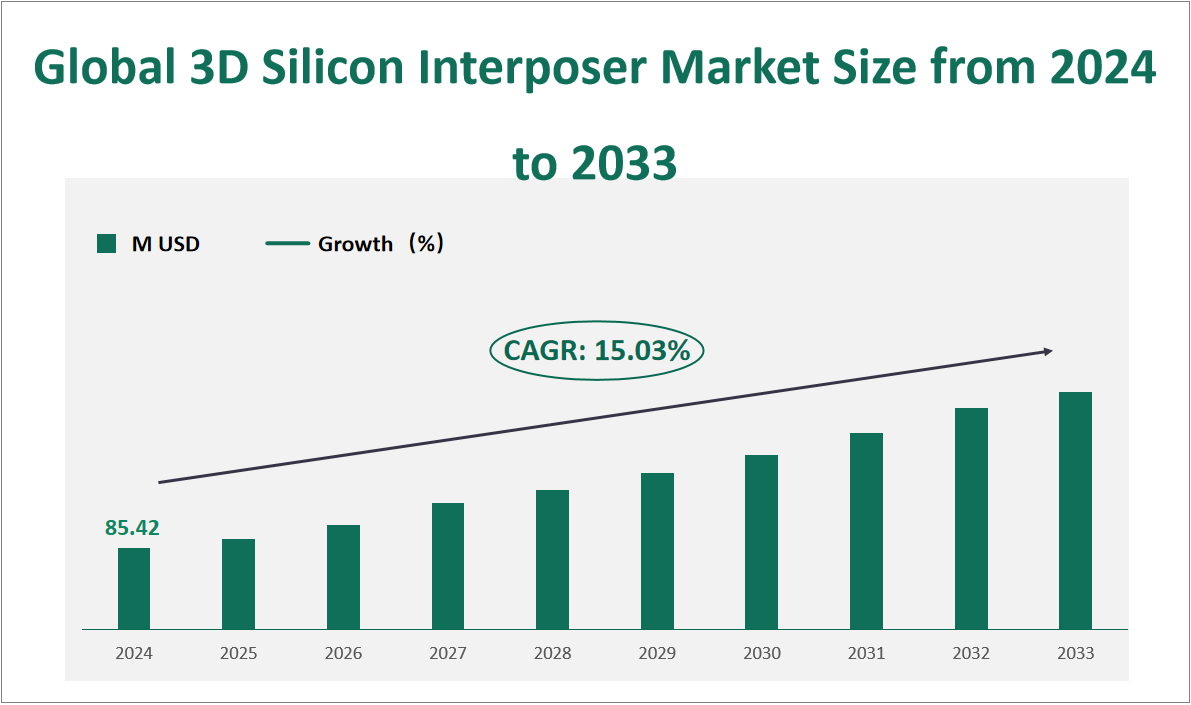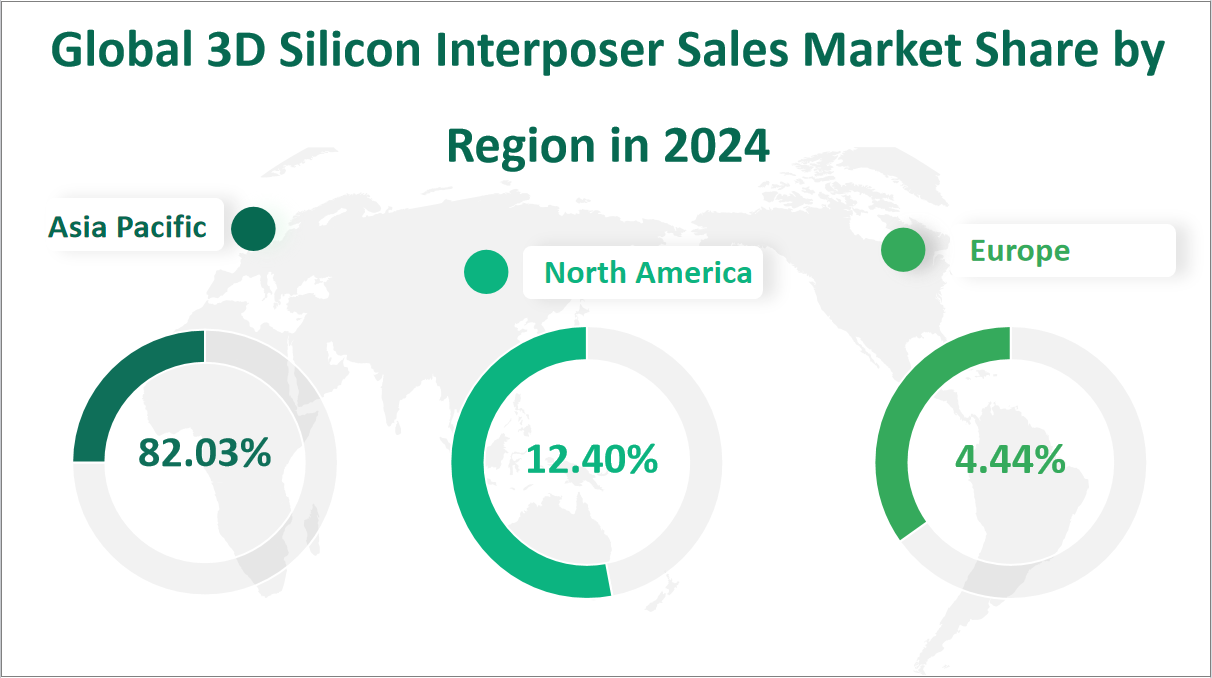1 Global 3D Silicon Interposer Market Outlook
The global 3D Silicon Interposer market is projected to exhibit substantial growth in the coming years, with a CAGR of 15.03% from 2024 to 2033, reaching a total market size of $85.42 million USD in 2024. An interposer, a silicon substrate made of silicon and organic materials, is the conduit through which electrical signals pass through multichip modules in advanced packaging. The intermediary layer is added between the substrate and the Die, which plays a role as a link between the previous and the next. With the help of the silicon intermediary channels extending in all directions, multiple Dies can be freely combined together, just like a giant underground transportation hub. The principle of a 3D Silicon Interposer is to make a transistor (CMOS) structure on the chip, and directly use TSV to connect the electronic signals of different chips up and down, so as to directly stack memory or other chips vertically on it.
Figure Global 3D Silicon Interposer Market Size and Growth Rate (2024-2033)

2 3D Silicon Interposer Market Growth Drivers and Constraints
The global 3D silicon interposer market is experiencing significant growth, driven by several key factors. Primarily, the increasing demand for advanced packaging technologies in various industries such as consumer electronics, automotive, aerospace, and pharmaceuticals is propelling market expansion. The need for higher integration density, reduced interconnection delay, and lower system power consumption has made 3D silicon interposers essential in semiconductor manufacturing.
The advent of 5G technology and the growth of the Internet of Things (IoT) are also contributing to the market’s upward trajectory. These technologies demand high-performance, compact, and energy-efficient devices, which 3D silicon interposers can provide. Additionally, the expansion of electric and autonomous vehicles has increased the demand for sophisticated electronic components, further stimulating the market.
Another driving factor is the continuous technological innovation in the semiconductor industry. As companies strive to develop smaller yet more powerful systems, 3D silicon interposers offer a flexible and efficient method for integrating different technologies, such as memory and logic circuits, into a single package. This integration not only enhances performance but also reduces the footprint of electronic devices.
Despite the promising growth, the 3D silicon interposer market faces certain challenges that could limit its expansion. High technical barriers, including the complexity of accurate interconnection parameter extraction and the need for high-density pin alignment, pose significant entry hurdles for new players. The industry also faces the threat of substitutes, as alternative packaging technologies like organic interposers and tunable glass interposers are being developed, which could potentially replace silicon interposers in certain applications.
Raw material price fluctuations, particularly in the silicon market, can impact the profitability of 3D silicon interposers. As silicon is a primary raw material, any increase in its price can affect the overall cost of production. Furthermore, the COVID-19 pandemic has disrupted the global semiconductor supply chain, leading to potential shortages of raw materials and challenges in maintaining supply chain continuity.
The market is also constrained by the impact of COVID-19 on the industry’s production and operation. Measures such as flight groundings, entry controls, and suspension of imports have hindered the circulation of the industrial chain and negatively impacted the economy of the 3D silicon interposer industry and its downstream sectors.
3 3D Silicon Interposer Market Innovations and M&A Activities
The 3D silicon interposer market is at the forefront of technological innovation in semiconductor packaging. Companies like TSMC, Murata Manufacturing, and Atomica are leading the way with their advanced offerings. TSMC, with its CoWoS®-L platform, combines the benefits of CoWoS® S and InFO technologies, providing flexible integration using interposers with local silicon interconnect (LSI) chips for die-to-die interconnect and redistribution layers (RDL) for power and signal delivery.
In terms of corporate activities, the market has seen strategic mergers and acquisitions that have shaped the competitive landscape. These activities have allowed companies to expand their technological capabilities, increase market share, and improve their service offerings. For instance, the merger of seven steel companies with Tata Steel under the Tata Group is expected to lead to operational integration and better facility utilization, enhancing the company’s market presence in certain product segments.
The market also witnessing BlueScope further expanding its business in the United States through the acquisition of Coil Coatings and MetalX, it demonstrates the company’s strategy of strengthening its market position and expanding its business scope through mergers and acquisitions. These moves not only strengthen the company’s market competitiveness, but also provide impetus for the further development of 3D silicon interposer technology.
In conclusion, the global 3D silicon interposer market is driven by technological advancements and expanding applications in various industries, but it also faces challenges that could limit its growth. Continuous innovation, strategic corporate activities, and the ability to adapt to market changes will be crucial for companies to maintain a competitive edge in this dynamic market.
4 Global 3D Silicon Interposer Market Analysis by Type
In 2024, the global sales of 3D Silicon Interposer are projected to reach 12,207 K cm2, with a market share distribution that is heavily skewed towards the 100 µm to 500 µm thickness category. Specifically, this segment is expected to account for 11,455 K cm2 of the total sales, capturing a substantial 93.84% of the market share. The 500 µm to 1000 µm thickness segment will contribute an additional 590 K cm2, holding a 4.83% market share. The remaining ‘Others’ category is projected to have a minimal impact, with only 162 K cm2 in sales and a 1.32% market share. This indicates a continued dominance of the thinner interposer types in the market, with the 100 µm to 500 µm range maintaining its stronghold as the preferred choice for manufacturers and consumers alike.
Table Global 3D Silicon Interposer Sales and Share by Type in 2024
Type | Sales in 2024 (K cm2) | Market Share in 2024 (%) |
|---|---|---|
100 µm to 500 µm | 11455 | 93.84% |
500 µm to 1000 µm | 590 | 4.83% |
Others | 162 | 1.32% |
5 Global 3D Silicon Interposer Market Analysis by Application
In 2024, the global 3D Silicon Interposer market is anticipated to showcase significant growth in sales across various applications. Specifically, the sales for Imaging & Optoelectronics are projected to be 2,147 K cm2, capturing a market share of 17.59%. The Memory application is expected to dominate with sales reaching 4,462 K cm2, accounting for a substantial 36.55% of the market share. MEMS/sensors will contribute 624 K cm2, holding a 5.11% share, while the LED application is forecasted to have sales of 235 K cm2, representing a 1.93% share. The Logic 3D sip/soc segment is projected to experience substantial growth, with sales estimated at 4,325 K cm2 and a market share of 35.43%. Lastly, the Others category is expected to have sales of 414 K cm2, which corresponds to a 3.39% market share. These figures highlight the diverse applications of 3D Silicon Interposers and indicate the Memory segment as the most significant contributor to the market, followed by Logic 3D sip/soc, which together are expected to drive the majority of the market’s growth in 2024.
Table Global 3D Silicon Interposer Sales and Share by Application in 2024
Application | Sales in 2024 (K cm2) | Market Share in 2024 (%) |
|---|---|---|
Imaging & Optoelectronics | 2147 | 17.59% |
Memory | 4462 | 36.55% |
MEMS/sensors | 624 | 5.11% |
LED | 235 | 1.93% |
Logic 3D sip/soc | 4325 | 35.43% |
Others | 414 | 3.39% |
6 Global 3D Silicon Interposer Market Analysis by Region
In 2024, the global 3D Silicon Interposer market is forecasted to exhibit regional sales of 12,207 K cm2, with distinct market shares allocated across various regions. North America is projected to contribute 1,535 K cm2 to the total sales, garnering a market share of 12.58%. Europe is expected to have sales of 553 K cm2, capturing a 4.53% share of the market. The Asia Pacific region continues to lead with an impressive 9,984 K cm2 in sales, which translates to a dominant 81.79% of the market share. The Others category, comprising other minor regions, is anticipated to record sales of 134 K cm2, holding a 1.10% share. These figures underscore the Asia Pacific region’s stronghold in the 3D Silicon Interposer market, while North America and Europe maintain significant though comparatively smaller market share. The collective sales and market share data for 2024 reflect a dynamic geographical distribution of the 3D Silicon Interposer market, highlighting the regions that are poised for growth and those with a stable yet smaller presence in the industry.
Figure Global 3D Silicon Interposer Sales Market Share by Region in 2024

7 Top 3 Companies of Global 3D Silicon Interposer Market
7.1 TSMC
Company Introduction and Business Overview:
TSMC, established in 1987 and headquartered in China, is the world’s leading independent pure-play semiconductor foundry. The company is renowned for its cutting-edge manufacturing processes and serves a diverse global customer base with a wide range of microchips used in communications, automotive electronics, and IoT devices.
Products Offered:
TSMC’s product portfolio is extensive, with a focus on 3D silicon interposers. Their flagship product, CoWoS®-L, combines the advantages of CoWoS® S and InFO technologies, offering flexible integration using interposers with Local Silicon Interconnect (LSI) chips for die-to-die interconnect and RDL layers for power and signal delivery.
Sales Revenue in Latest Year :
TSMC achieved a remarkable revenue of USD 28.81 million from its 3D silicon interposer sales, showcasing its market leadership and the success of its advanced products in meeting the demands of high-performance semiconductor applications.
7.2 Murata Manufacturing
Company Introduction and Business Overview:
Murata Manufacturing, founded in 1944 and based in Japan, is a global leader in the manufacturing and sale of electronic modules and components. The company has a broad product range, including communication modules, power supply modules, multilayer ceramic capacitors, and sensor devices, catering to various industries such as automotive, medical, and consumer electronics.
Products Offered:
Murata’s 3D silicon interposer offerings include a variety of solutions from basic 2D interposers to advanced 3D interposers with integrated passive components. These products are designed to meet the diverse interposer requirements of customers across different sectors.
Sales Revenue in Latest Year :
Murata Manufacturing reported a revenue of USD 15.87 million from its 3D silicon interposer sales, indicating its strong position in the global market and the continued demand for its electronic components.
7.3 Atomica
Company Introduction and Business Overview:
Atomica, established in 2000 and headquartered in the USA, is a company with extensive experience in MEMS, photonics, sensors, and microfluidic biochips. Atomica partners with innovative companies to deliver breakthrough solutions in cloud computing, autonomous vehicles, and IoT, among other areas.
Products Offered:
Atomica’s product portfolio focuses on through silicon vias (TSV) and interposers that are critical for large-scale 3D integration. These products allow for smaller device sizes, reduced signal path lengths, and increased integration while maintaining or shrinking the footprint.
Sales Revenue in Latest Year :
Atomica achieved a revenue of USD 6.85 million from its 3D silicon interposer sales, demonstrating its competitive presence in the market and the effectiveness of its MEMS-based solutions.

